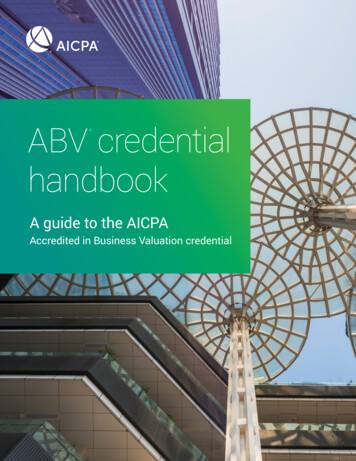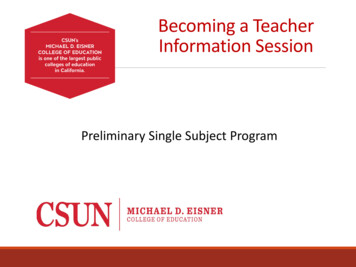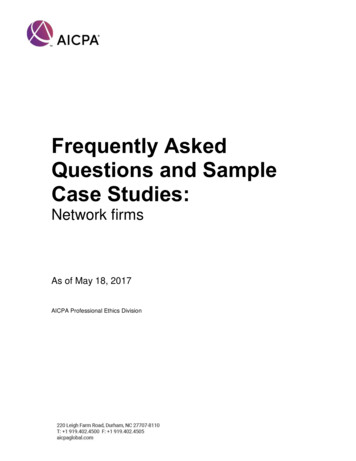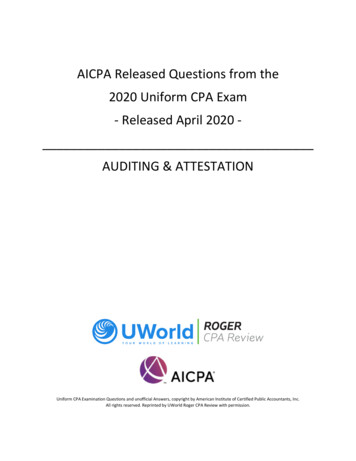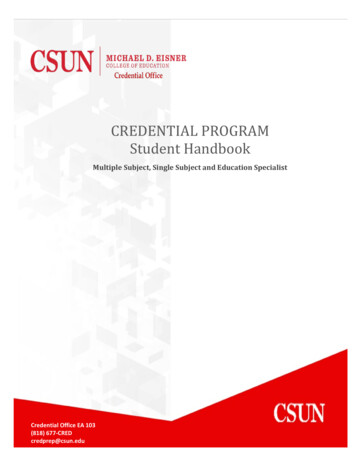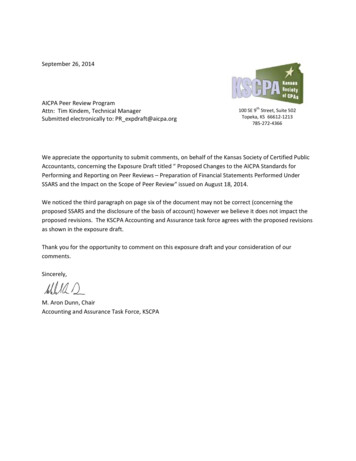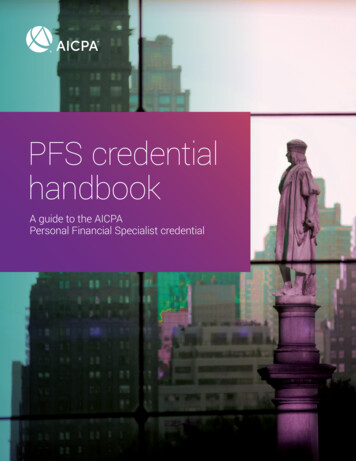
Transcription
PFS credentialhandbookA guide to the AICPAPersonal Financial Specialist credentiali PFS handbook — A guide to the AICPA Personal Financial Specialist credential
Disclaimer: The contents of this publication do not necessarily reflect the position or opinion of the Association ofInternational Certified Professional Accountants, its divisions and its committees. This publication is designed to provideaccurate and authoritative information on the subject covered. It is distributed with the understanding that the authorsare not engaged in rendering legal, accounting or other professional services. If legal advice or other expert assistance isrequired, the services of a competent professional should be sought.For more information about the procedure for requesting permission to make copies of any part of this work, please emailcopyright@aicpa.org with your request. Otherwise, requests should be written and mailed to the Permissions Department,AICPA, 220 Leigh Farm Road, Durham, NC 27707–8110.ii PFS handbook — A guide to the AICPA Personal Financial Specialist credential
Contents2What is the CPA/PFS credential?3Six great reasons to obtain the CPA/PFS credential4CPA/PFS pathway — your professional development roadmap5Valuable resources, tools and information6PFS application process (It’s easy to apply!)7CPA/PFS Body of Knowledge9Experience requirement9Education requirement10 Examination requirement10 Reinstating a lapsed CPA/PFS credential11 FAQs12 Preparing for the exam requirement13 Costs to prepare for and take the PFS exam1 PFS handbook — A guide to the AICPA Personal Financial Specialist credential
What is the CPA/PFS credential?All financial planners are not created equal. The AICPA’s Personal Financial Specialist(PFS ) credential is granted exclusively to CPAs with the powerful combination ofextensive tax expertise and comprehensive knowledge of financial planning. Thisknowledge is critical for obtaining the most valuable, objective advice possible. All areasof personal financial planning — including estate, retirement, investments and insurance— have tax implications, and only CPA/PFS professionals have the experience, ethics andexpertise to get the job done right.The CPA/PFS credential program has several key objectives: Standardize and enhance the quality of PFP services that CPA financial planners provideby serving as the CPA exclusive mark of excellence in financial planning Increase practice development and career opportunities for CPA/PFS credential holders Help credential holders promote their practices through the PFP website and thedevelopment of CPA/PFS marketing tools Increase professional and public awareness of CPA/PFS as the preferred personalfinancial planning credential2 PFS handbook — A guide to the AICPA Personal Financial Specialist credential
Six great reasons toobtain the CPA/PFScredential1. Enables you to become recognized for providingfinancial planning services by prospects, clients andreferral sources2. Distinguishes you from other financial planners —only CPAs can hold the CPA/PFS credential3. A ffirms your value to current and potential clients andemployers, and inspires a greater level of confidencein your expertise4. I ndicates your continual dedication to delivering thebest service possible to your clients by honing yourfinancial planning skills and expertise5. Enhances your image as a trustworthy financialplanner; only active AICPA members who abide bythe AICPA Code of Conduct can hold the CPA/PFScredential6. A ffords access to a CPA community in which you canshare, debate, network and grow with other personalfinancial planning experts3 PFS handbook — A guide to the AICPA Personal Financial Specialist credential
CPA/PFS pathway —your professionaldevelopment roadmapUse the following steps to guide your thinking as you approach the CPA/PFS credential. This handbook(and aicpa.org/pfs) provide more information on the CPA/PFS requirements and body of knowledge.FirstSecondConsider joining the PFP Section.Decide on your pathway to the PFS credential.The PFP Section provides discounts on the education,review and exam materials that exceed the membershipfee. Additionally, members have access to resourcesto use as they gain experience and participate in acommunity of like-minded CPA financial planners.All pathways require a valid and unrevoked CPA licenseand an AICPA membership. As you select a pathway,factors such as your experience, the time you haveavailable to study and costs will influence your decision.CPAs holding the CFP or ChFC designations are deemedto have met the PFS credential exam requirement.Develop PFP competency — Regardless of the pathway, the AICPA has in-depth online learning courses covering the entirePFP Body of Knowledge. With five courses, totaling 92 hours of CPE broken into 35 modules, they not only provide thetechnical knowledge needed, but emphasize the planning process, income tax planning in each area, and integration with theclient’s entire financial plan.Pathway benefits and action stepsStandard pathwayCertificate pathwayExperienced pathwayGood for a CPA withsome experience (upto the 3,000 hours) andsome knowledge whowants to expand theirlearning and get theexam requirement doneall at one time.Good for less experienced CPA practitioners looking fora systematic, methodical approach to learning looking tofit the education and exam modules into a busy schedule.Good for experienced CPA practitioners(more than 7,500 hours) looking for astreamlined and cost-effective approachthat takes into account the competencyand expertise their substantial experienceprovides. Obtain the learningyou need based onyour experience Sit for thecomprehensivePFS exam Complete all four technical PFP certificates — withonline education followed by web-proctored exams onyour computer– Retirement Planning– Estate Planning– Investment Planning– Risk Management/Insurance Planning Complete the PFP Practical Applications certificate —covering the PFP process, regulatory environment, andpractical case studies Complete the PFS Experienced CPAEducation — a 13-hour self-study CPEcourse focusing on the PFP process,professional responsibilities, andpractical case studies. Sit for the PFS Experienced CPAAssessment — multiple-choice exambased on the CPE case studies.ThirdFourthWhile you are working through your selected PFScredential education and exam pathway, you should alsofocus on your PFP-related experience needed for thatparticular pathway. Verify that you have either met it, orwork with your firm to obtain the needed hours.Verify that you have met all of the requirements for thecredential and go to aicpa.org/pfs to apply.Obtain your required PFP experience.Apply online for the PFS credential.4 PFS handbook — A guide to the AICPA Personal Financial Specialist credential
Valuable resources,tools and informationCPA/PFS credential holders receive:CPA/PFS Marketing Toolkit — Includes CPA/PFS logosand guidelines, media and public relations resources,PowerPoint templates, sample press releases, pressreleases and talking points on current topics, copy-readyprint advertisements and client brochuresConsumer Referral Program — Clients can visitfindaCPAPFS.org to both learn why they should choosea CPA/PFS, and to search for a local CPA/PFS in anonline directory.Public and Media Awareness Program — Publicrelations opportunities, e.g., writing, speaking and mediainterviews, plus media training for CPA/PFS credentialholdersPlus, these PFP Section benefits:Technical resources — Tools and information via thePFP website Client Education and Communication Tool —Broadridge Advisor includes 3,000 technicaland leg/reg topics explained in layman’s terms( 499 value; free to PFP Section members) Practitioner newsletter service — Bob Veres’ InsideInformation is considered a must-read by seasonedCPA financial planners ( 349 value; free to PFP Sectionmembers) Free webcasts and related materials — CPA expertsfrom around the country host timely seminars onestate, tax, investment, retirement, insurance planning,practice management and leg/reg issues (discountedCPE available — save 200 a year!) Resource guides for CPAs — Such as the four-volumeThe Adviser’s Guide to Financial and Estate Planning andfour Adviser’s Guides on Retirement, Social Security,Retirement Healthcare and Elder Planning. PFP Practice Center — Resources for starting orgrowing a CPA financial planning practice;includes practice guides such as The CPA’s Guide toInvestment Advisory Business Models, The CPA’s Guideto Technology in a PFP Practice and The CPA’s Guide toDeveloping and Managing a CPA Practice oney-saving discounts — 100 off already-reducedMAICPA member prices for AICPA PFP-relatedconferences and the PFS Exam; 20% off already-reducedprices for the PFP Certificate Programs and selectedAICPA PFP publications; 20% off other Broadridgeproducts; discounted CPE; and discounts on otherproductsA voice in leg/reg issues — As the voice of CPA financialplanners on Capitol Hill, the PFP Section protects thepublic — and member — interest Personal FinancialPlanning SectionTax, retirement, estate,risk management andinvestments5 PFS handbook — A guide to the AICPA Personal Financial Specialist credential
PFS applicationprocess(It’s easy to apply!)Apply online (preferred method): Go to aicpa.org/pfs and click on the Apply button.1.2. Check off the boxes for the examinations, education,experience and attestations.3. Include payment information for your application feeand submit the application.Apply with paper at one of our conferences:1. Obtain a copy of the PFS application2. Complete and sign the application form3. Submit your completed applicationand application feePayable by check or credit cardPFS recertificationrequirementsTo maintain an active CPA/PFS credential, and maintainaccess to all of the accompanying resources and tools,CPA/PFS credential holders must pay an annual renewalfee and meet the following CPA/PFS recertificationrequirements annually:1. Regular AICPA membership in good standing2. Valid and unrevoked CPA permit, license or certificateissued by a legally constituted state authority3. C omplete 20 hours of continuing professionaldevelopment within the credential body of knowledgeannually: Continuing professional development may includestructured learning activities approved by NASBA or alegally constituted state authority, or other professionalbody; or unstructured learning activities as outlined bythe AICPA Unstructured learning activities may constitute up to50% (10 hours annually) of a credential holder’s CPD tomeet credential renewal requirementsInitial certificationrequirements4. P ayment of current-year credential fees includesattestation to comply with all recertificationrequirements Regular AICPA membership in good standingPFS annual audit Valid, unrevoked CPA permit, license or certificateissued by a legally constituted state authority Completed PFS application indicating fulfillment of allrequirements Payment of PFS application feeA percentage of approved PFS applications andrecertifications are selected for random audit by theAICPA. Any misrepresentations or incorrect informationprovided to the AICPA can result in disciplinary action,including suspension or revocation of CPA/PFS eligibilityand/or the CPA/PFS credential.Credential holders will be notified in writing when selectedfor audit and be instructed to report their recertificationrequirements at the appropriate time.6 PFS handbook — A guide to the AICPA Personal Financial Specialist credential
CPA/PFS Body ofKnowledgeEligible business experience and education andlifelong learning must fall within the 12 practice areascomprising the CPA/PFS Body of Knowledge. Note thatwhile income tax planning does not appear as a separatetopic, both taxation and income tax planning are coveredas a part of each area in the body of knowledge.1. Personal Financial Planning Process Applying all steps in the standard financial planningprocess to clients Gathering data and helping clients establish theirfinancial goals Building rapport with client and addressing familydynamics in the client relationships2. Professional Responsibilities and Legislative andRegulatory Environment Applying the principles of the Statement onStandards in Personal Financial Planning Services toany aspect of the client relationship Complying with any requirements for licensingwith the state or federal authorities for the services orproducts provided3. Fundamental Financial Planning Concepts Reviewing income and spending patterns; developingrecommendations for cash flow management andbudgeting R eviewing tax and probate considerations ofvarious forms of property ownership; makingrecommendations on the titling of assets Developing strategies for minimizing estate and deathtaxes and achieving the clients’ other estate-planninggoals Recommending or reviewing various instruments(e.g., wills, powers of attorney, trusts) for use inachieving goals Planning for post-mortem succession of a closelyheld business (e.g., buy-sell agreements, estate freezetechniques, valuation issues)5. Charitable Planning Evaluating client’s assets to use for charitable giving Determining the advantages and disadvantagesof charitable giving through different vehicles (e.g.,conservation easements, charitable trusts, lifeinsurance) Summarizing income tax consequences of variouscharitable giving options6. Risk Management Planning Analyzing client exposure to risks and recommendingmethods for managing risk Advising clients on various types and uses of lifeinsurance Performing “time value of money” calculations fordecisions such as refinancing a home or buying vs.leasing a motor vehicle Helping clients minimize their financial risks fromdisability; illness; property damage; and personal andprofessional liability Determining strategies for tax liability management Planning for long-term health care for clients andtheir families4. Estate Planning Helping clients develop or refine their financial andpersonal estate planning goals Reviewing proposed policies to ensure clients’ needsare satisfied Estimating liabilities for federal estate tax, state deathtaxes and other obligations; determining cash needsupon death Reviewing income and estate tax aspects ofinsurance coverage with clients Developing recommendations to meet financialobligations upon death7 PFS handbook — A guide to the AICPA Personal Financial Specialist credential
7. Employee and Business-Owner Planning10. Elder, Special Needs and Chronic Illness Planning Analyzing and making recommendations onexecutive compensation and stock options Helping clients understand the variety of care optionsthat are available to them Evaluating or reviewing various benefits (equity, fringeand insurance) available to employees of public andprivate companies Analyzing financial aspects and assisting clients withhousing-related decisions Evaluating the implications of strategies for timingexercise and sale of equity employee benefits Examining tax implications of benefits for employerand employees Planning with business owners on decisions abouttheir business that affect their current or futurepersonal financial goals8. Investment Planning Year-end capital gain/loss recognition planning;deferral of capital gain strategies Reviewing client investment preferences and risktolerance to help them develop appropriateinvestment strategies Discussing available investment options with clients Monitoring the performance of invested assets Providing asset allocation recommendations Recommending investments or helping clients buildportfolios Providing bill pay or other personal financial servicesfor clients Developing plans to address current and futurefinancial expenses for special needs clients11. Education Planning Assisting clients with understanding the educationplanning process Developing recommendations for education fundingstrategies Assessing income tax implications for educationfunding strategies12. Special Situations Defining clients’ housing goals Planning income needs and evaluating division ofassets during a divorce Advising clients on household employeesFor more detailed information on the credential body ofknowledge, please look at the Preparation tab ataicpa.org/pfsexam. Managing client assets9. Retirement and Financial Independence Planning Helping clients develop or refine retirement planninggoals; determining cash requirements to realize thosegoals Calculating savings needed to meet retirement cashrequirements and analyzing available retirementplans Reviewing limits on and tax consequences ofcontributions to or distributions from retirement plans Establishing retirement plans Planning for retirement plan withdrawals Assisting clients with maximizing their SocialSecurity benefits Planning for post-retirement succession of a closelyheld business8 PFS handbook — A guide to the AICPA Personal Financial Specialist credential
ExperiencerequirementFor the Standard and Certificate pathways, a CPA/PFScandidate must meet the following business experiencerequirements within the five years preceding the dateof the PFS application:1. Two years of full-time experience (or 3,000 hoursequivalent) in personal financial planning (Note: Afull-time equivalent is defined as 1,500 hours per year).2. Up to 1,000 hours of tax compliance experiencecan count toward the total experience requirement.For candidates in academia, a qualified credentialholder should be a full-time professor and havetaught at least four accredited college courseswith 50% of their material included in the PFS Bodyof Knowledge.For the Experienced pathway, a CPA/PFS candidatemust meet the following business experiencerequirements within the seven years preceding the dateof the PFS application:1. Five years of full-time experience (or 7,500 hoursequivalent) in personal financial planning (Note: Afull-time equivalent is defined as 1,500 hours per year).To the extent that any NASBA-approved CPE is part of therequired hours, CPAs are responsible for complying with allapplicable CPE requirements, rules and regulations of stateboards of accountancy, as well as those of membershipassociations and other professional organizations. Visitaicpa.org/cpe-learning/cperequirements.html to becomefamiliar with the CPE Standards issued by AICPA andNASBA, learn the continuing professional development(CPD) requirements for AICPA members and find outthe specific CPE requirements for each state board andsociety. The following categories of education are eligible: ontinuing professional development (CPD)CCredit will be given for structured programs of learning inself-study or group-study format on topics relevant to theCPA/PFS Body of Knowledge. Other structured learningoptions include:1. Approved courses at an accredited university or collegeFor university or college courses taken within theCPA/PFS Body of Knowledge that meet CPErequirements.2. Up to 2,000 hours of tax compliance experience cancount toward the total experience requirement. 2. PresentingInstructors receive credit for preparation andpresentation of CPE or college credit courses on topicswithin the CPA/PFS Body of Knowledge.Educationrequirement3. AuthoringWriters of published articles, books or CPE programson topics within the CPA/PFS Body of Knowledge willbe given credit for research and writing time if this timeincreases professional competence.For the Experienced pathway, a CPA/PFS candidate mustearn 105 hours of personal financial planning continuingprofessional development (CPD) within the seven yearspreceding the date of PFS application.In recognition that learning is not limited to the classroom,credit will also be given for unstructured learning, whichmay include activities such as coaching, mentoring, peerto-peer learning and on-the-job training that a memberrecords on the AICPA competency learning record asit happens. These expanded opportunities allow you todevelop professional competencies necessary to supportcontinued success in your area of specialization.For the Standard and Certificate pathways, a CPA/PFScandidate must earn 75 hours of personal financialplanning continuing professional development (CPD)within the five years preceding the date of PFS application.The AICPA offers a complete curriculum of 92 CPEhours of online PFP education covering the entire PFPBody of Knowledge. It is made up of five courses brokeninto 35 online modules. For more information, seepfpcert.AICPAStore.com9 PFS handbook — A guide to the AICPA Personal Financial Specialist credential
Reportingrequirements tosupport CPA/PFSeducationThe AICPA recommends that you maintain thefollowing records about your education becauseit is subject to random audit and may need to beverified by the AICPA: Title of program/session Related body of knowledge subject matter Number of CPE credits awarded to participantsor length of presentation Date(s) and location of presentationAuthoring: Title of work Related body of knowledge subject matter Name of publisher Type of publication Date published Number of hours to prepareUnstructured Learning: Date(s) of activities Title of activityExaminationrequirementPFS applicants are required to pass one of three examoptions: the comprehensive PFS exam, the requirementsfor each of the five PFP Certificates offered by the AICPAwithin a five-year period or the PFS Experienced CPAAssessment. For more information on the PFS exam, whenit is offered, and how to prepare, go to aicpa.org/pfsexam,or see the ersonal-financial-planning for information on thePFP certificate exams. However, if you have passed either ofthe following exams, you are waived from this requirement:- Certified Financial Planner (CFP ) exam- Chartered Financial Consultant (ChFC) examReinstating a lapsedCPA/PFS credentialCPAs who have held the CPA/PFS credential in the past canreinstate their credential by attesting that they have taken atleast 60 hours of PFP-related CPD in the last three years.There is a one-time 100 reinstatement fee, in addition tothe annual credential fee. The link to the PFS reinstatementform can be found at . Format and length of activity How the activity supports yourcontinued development10 PFS handbook — A guide to the AICPA Personal Financial Specialist credential
FAQsQ. Do I have to be a CPA and a member of the AICPAto apply?Q. I have applied for the CPA/PFS credential. Whathappens next?A. Yes. You must be a Regular member (CPA) in goodstanding of the AICPA and hold an unrevoked CPApermit, license or certificate issued by a legallyconstituted state authority. The CPA/PFS credentialis granted exclusively by the AICPA.A. Once application and payment have been submittedeither via online or paper application, the AICPAwill review and issue a welcome letter. At this time:Q. Do I need an active CPA license to practice publicaccounting to become a CPA/PFS?1. Individuals may use the CPA/PFS credential inaccordance with the rules of the state in whichthey practice. Members are not authorized to usethe credential until they receive this notice.A. No. You must hold a valid and unrevoked CPA permit,license or certificate issued by a legally constitutedstate authority.2. At the applicant’s request, their state society willbe notified so the information can be promoted instate society newsletters.Q. Do I need to be a PFP Section member to apply tobecome a CPA/PFS credential holder?Q. What is required to maintain the CPA/PFScredential?A. No. You need to be an AICPA member in goodstanding and meet the unrevoked CPA certificaterequirement. PFS holders receive complimentary PFPSection membership.A. Credential holders must pay an annual fee and meetPFS recertification requirements annually:Q. If I don’t meet the requirements to become aCPA/PFS credential holder, is there another way toget information about personal financial planning?A. Yes. You may join the PFP Section — the onlyrequirement is AICPA membership in good standing.(Non-CPAs must join the AICPA as a Non-CPAAssociate.)Q. Does the AICPA audit CPA/PFS applications?A. Yes. A percentage of approved applications areselected for random audit. Any misrepresentations orincorrect information may result in disciplinary action,including suspension or revocation of CPA/PFSeligibility and/or credential.Q. How do I apply for a waiver of the Series 65 basedon my CPA/PFS credential?1. AICPA membership in good standing2. Valid and unrevoked CPA certificate issued by alegally constituted state authority.3. Complete 20 hours of continuing professionaldevelopment (CPD) within the credential body ofknowledge annually: CPD may include structured learning activitiesapproved by NASBA or a legally constitutedstate authority, or other professional body; orunstructured learning activities as outlined by theAICPA Unstructured learning activities may constitute upto 50% (10 hours annually) of a credential holder’sCPD to meet credential renewal requirements4. Payment of the annual fee with the associatedattestation of intent to comply with all credentialrecertification requirements.A. If you have supplied your individual (not your firm’s)CRD number on your CPA/PFS application, you areincluded in a file the AICPA sends weekly to FINRA.Check the box on FINRA’s Form U-4 that indicatesyou hold the CPA/PFS credential; FINRA willcompare your U-4 information against the AICPA file(authorizing the Series 65 waiver). If you receive notice FINRA does not have a record of yourCPA/PFS, it may be due to a missing/incorrect CRD numberon your PFS application. Contact the AICPA Member Service at888.777.7077 to update your CRD number; then, resubmit the U-4to FINRA.11 PFS handbook — A guide to the AICPA Personal Financial Specialist credential
Preparing for theexam requirementWhether you are first-year staff or a seasoned CPA,the AICPA Personal Financial Planning (PFP) Sectionhas the resources you need to gain a fundamentalunderstanding of PFP and obtain the CPA-exclusivePFS credential.Preparing for the PFSexperienced CPAassessmentIf you are qualifying under the substantially higherexperience requirement of the Experienced pathway, thenconsider the following approach.Follow the steps outlined below to create yourpersonalized approach to the PFS exam and education:1. Complete all of the modules in the PFS ExperiencedCPA Education course.1. Review the PFP Body of Knowledge.This provides both a high-level outline and a moredetailed outline of the topics the PFS exam covers.Use this information to identify areas where additionaleducation or review may be needed, based on yourcurrent education and experience.The case studies in this course will be on the PFSExperienced CPA Assessment.2. Use the online PFP education for topics where you needin-depth education. These five courses are availablefrom the AICPA: Retirement PlanningEstate PlanningRisk Management and Insurance PlanningInvestment PlanningPFP Practical ApplicationsAs a seasoned CPA, you could select a few courses tocomplement your current knowledge. As a CPA just entering the PFP field, you would benefit from learningfrom all five courses as a solid foundation to build on inthe future. More information on the courses can be foundat ersonal-financial-planning.2. Use the PFS Body of Knowledge to review for theAssessment.For each of the case studies, review the technicaltopics in the PFP Body of Knowledge and focus yourattention on those topics you would likely address forthe demographics/situation of that type of client.You will likely draw on your longer PFP experience tobe prepared for the Experienced CPA Assessment.3. Sign up and pass the PFS Experienced CPAAssessment.The exam is a 60-question multiple choice examwith one part for each of the four case studies, to becompleted in 100 minutes.For more information on each step, go toaicpa.org/pfsexam.If you choose to, you could take the certificate exam aftereach of these five courses instead of continuing on andtaking the comprehensive exam. Some like to get the PFSexam done all at once, and others like to fit the certificateexams into their schedule over time.3. Sign up for the comprehensive PFS exam.As you prepare, you should determine which PFS examwindow will fit your schedule and register in advanceboth to get the date and location you desire and toprovide yourself with a target date to improve yourstudy habits. Purchasing the PFS exam will provide youwith a voucher that is good for a 12-month period fromwhen it was purchased to complete the PFS exam.12 PFS handbook — A guide to the AICPA Personal Financial Specialist credential
Costs to prepare forand take the PFSexamAs a CPA, you are aware of the need for professionaldevelopment. The expertise that you acquire as a partof the online education courses and the exam-preparationprocess will pay immediate dividends in the form ofstronger client relationships and more revenue. Beingable to display your CPA/PFS credential clearlydemonstrates the results of this certification processto your clients and prospects. The AICPA PFP Sectionprovides many ways to reduce the costs related toexam preparation and obtaining the CPA/PFS credential.The best discounts are provided to PFP Sectionmembers. You also have access to all the sectionresources. For more information on the PFP Section,go to aicpa.org/pfp.13 PFS handbook — A guide to the AICPA Personal Financial Specialist credential
P: 888.777.7077 F: 800.362.5066 W: aicpa.org/pfs 2021 Association of International Certified Professional Accountants. All rights reserved. AICPA and American Institute of CPAs are t
Broadridge Advisor includes 3,000 technical and leg/reg topics explained in layman's terms ( 499 value; free to PFP Section members) Practitioner newsletter service — Bob Veres' Inside Information is considered a must-read by seasoned CPA financial planners ( 349 value; free to PFP Section members)
